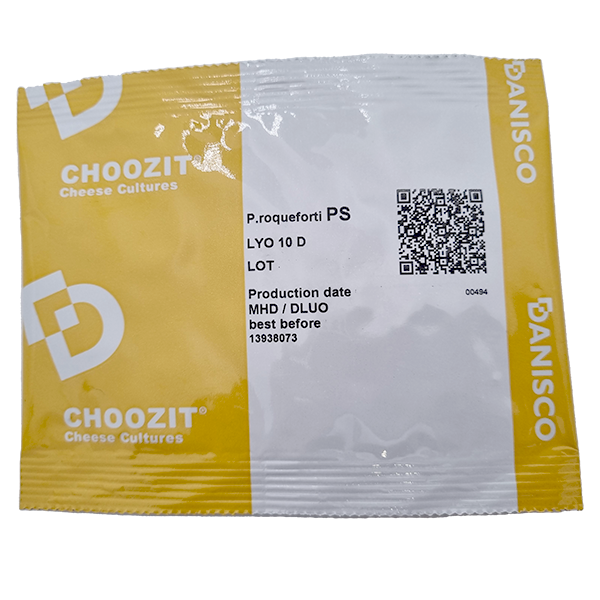Dosage and pack size
· Large size will inoculate 5,000 litres of milk (foil sachet).
· Small size will inoculate 500 litres of milk (screw cap bottle).
· 1/4 drop spoon into 8 litres of milk.
Types of Blue Mould Spores can be used on
All Blue Vein styles, Blue/Cam Blue.
Benefits of using PA ROQ
- Each blue mould will provide its own characteristics to the flavour and ripening of the cheese. PS ROQ has medium growing rate mould culture with high lipolytic (breakdown of fat) and low proteolytic (breakdown of proteins) activity.
- PS ROQ produces a dark blue-green marbled interior, PS ROQ has a piquant aroma, with a very long shelf life.
- Ideally suited for Stilton and Gorgonzola Picante style cheeses.
Cheesemaking tips for getting the best from PA ROQ
Blue mould is the generic name given to Penicillium Roqueforti.
- PA ROQ is in a powdered format.
- Remove ¼ drop spoon of the powdered mould spores using the mini spoons (or a heaped tip of a skewer and add to approximately 20ml of warm milk that is being used to make the cheese. Allow 30 minutes or longer for the powder to dissolve, stirring a few times, before adding it back to the milk. Ideally, add the spores at the same time the lactic starter cultures are added to the milk.
- Requires oxygen to stimulate sporing and maintain the colour but will grow at low oxygen levels. Hence openings in the cheese are desirable to get greater mould growth.
- Mould growth slows below 8°C.
- The optimum salt for blue mould growth is 0% to 3%.
- The optimum pH growth is 4.0 to 7.0.
- Each blue mould will provide its own characteristics to the flavour and ripening of the cheese.
- Ideally use lactic culture MA221 or LM57 to obtain a more open texture and more blue veining plus increased flavour development.
- Keeping curds whole during stirring and hooping is critical to obtaining blue veins in the cheese.
- Wrapping white mould cheese in professional cheese wraps allows the ammonia developed during ripening to escape while maintaining moisture.
- Ripening wrapped cheese at temperatures below 1°C – 7°C is recommended to slow proteolysis but allow lipolysis to keep progressing. This provides a slower ripening time but better all-round flavour development.

